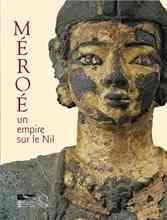“Meroë. An empire on the Nile”, will highlight the vestiges of a mysterious Southern Sudanese civilization, rediscovered in 1821 by the Frédéric Cailiaud. The kingdom is believed to have appeared at the end of the Late Egyptian period (-270 to 400) around the same period the Ptolemies seized Egypt (-323).
 The “highly Egyptianized” and great empires of Kerma and Napata had conquered the region earlier, leaving Egyptian legacies like what is witnessed in the case of the Meroitic Pantheon, where Amun, the creator deity “par excellence”, is opulently displayed. Their funeral tradition is also very marked by Egyptian influences. Royal sepulchers, for example, were constructed in pyramid-like shapes. The representation of Meroë royalty is also very similar to what was practiced in Egypt. The royal statuary, in particular, bears the royal insignia of Egypt (the postiche or false beard per example). But Egypt is not the only culture that is seemingly represented.
The “highly Egyptianized” and great empires of Kerma and Napata had conquered the region earlier, leaving Egyptian legacies like what is witnessed in the case of the Meroitic Pantheon, where Amun, the creator deity “par excellence”, is opulently displayed. Their funeral tradition is also very marked by Egyptian influences. Royal sepulchers, for example, were constructed in pyramid-like shapes. The representation of Meroë royalty is also very similar to what was practiced in Egypt. The royal statuary, in particular, bears the royal insignia of Egypt (the postiche or false beard per example). But Egypt is not the only culture that is seemingly represented.Meroe nevertheless developed its own characteristics. The empire had its own writing, divided into two distinct graphical systems, and 24 signs (just like in Egypt, which had two types of writing; hieroglyphic and cursive). The Meroitic writing was discovered over a 100 years ago. Currently, experts are able to read and decipher the writings, although they do not understand it. In the area of translation, archaeologists still have much to learn.
The Louvre museum unveils the history and various aspects of the Meroë empire and culture through objects retrieved from the Louvre sponsored Mouweis excavations as well as loans from Sudanese and British museums. The objects on display highlight Meroitic royalty and religion, language and writing, objects of everyday use, a showcase of the Mouweis excavations, as well as the end of Meroe.
Visitors will discover exceptional museum pieces, including the famous statue of the archer King, lent by the British Museum. Discovered in 1974 in Tabo, the royal statue, in gilded bronze, is the largest Meroitic metallic piece to have been discovered so far. Another centerpiece of the exhibition is a bifacial stone (dating from the first century AD) depicting a Queen (or a Candace, as it were among the Meroës) receiving the breath of life from the patron goddess, Amesemi (wife of Apedemak, the lion god). Believed to be of Egyptian influence, the stele shows a Queen with a generous body and whose face and neck bear scarification marks, a sub-Saharan influence.
The exhibition runs until September 6.
Source: Egypt: Then and Now





